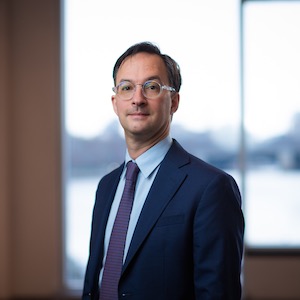Elliott lecture on electrolysis
October 12, 2023
5:00 p.m. ET
Hamerschlag Hall B103
October 12, 2023
5:00 p.m. ET
Hamerschlag Hall B103
Iron and steel are at the basis of modern society and their affordable and environmentally respectable extraction and recycling is expected. A global population of 9 billion people by 2050 and societal issues such as mitigation of greenhouse gas emissions provide unique opportunities for the deployment of new technologies for metals extraction and processing. Anticipating affordability and deployment of sustainable electric power generation [1], the electrification and intensification of metals and mining industry processes is becoming a possibility. This seminar starts with reporting a methodology and analysis of existing commodity metal extraction processes from a CO 2 emissions, electricity and cost standpoint. In a second time, the results are used to put forth a set of metrics for alternative technologies based on electricity [2,3,4]. Finally, results for process scale-up in various electrolytes; aqueous alkaline [5,6,7], molten oxides [8] and sulfides [9] are reviewed, highlighting recent discoveries and acceleration toward industrial demonstration.
[1] A. Allanore, Contribution of Electricity to Materials Processing: Historical and Current Perspectives, JOM, 65(2),131, (2013)
[2] A. Allanore, Electrochemical Engineering for Commodity Metals Extraction, Electrochem. Soc. Interface, 26 (2),63-68, (2017)
[3] C. Stinn and A. Allanore, Estimating the Capital Costs of Electrowinning Process, Interface, 29, 44-49, (2020)
[4] A. Allanore, Features and Challenges of Molten Oxide Electrolytes for Metal Extraction, Journal of the
Electrochemical Society, 162(1), 13-22, (2015)
[5] A. Allanore, et al., Electrodeposition of Metal Iron from Dissolved Species in Alkaline Media, Journal of the
Electrochemical Society, 154(12), 187-193, (2007)
[6] A. Allanore, et al., Iron Metal Production by Bulk Electrolysis of Iron Ore Particles in Aqueous Media, Journal of the Electrochemical Society, 155(9), 125-129, (2008)
[7] A. Allanore, et al., Observation and modeling of the reduction of hematite particles to metal in alkaline solution by electrolysis, Electrochimica Acta, 55, 4007-4013, (2010)
[8] A. Allanore, L. Yin & D. R. Sadoway, A New Anode Material for Oxygen Evolution in Molten Oxide Electrolysis. Nature, 497(7449), 353–356, (2013)
[9] K.E. Daehn, et al, Liquid Copper and Iron Production from Chalcopyrite, in the Absence of Oxygen. Metals, 12 (9), (2022) (https://doi.org/10.3390/met12091440)
 Allanore is a Professor of Metallurgy in the Department of Materials Science and Engineering, currently recipient of the Heather N. Lechtman Chair. Professor Allanore received his higher education in Nancy (France) where he earned a chemical process engineer diploma from Ecole Nationale Supérieure des Industries Chimiques and a M.Sc. and a Ph.D. from Lorraine University. He joined the Massachusetts Institute of Technology in 2010 as a post-doctoral with Professor Sadoway, after several years of service as research engineer for ArcelorMittal (Ulcos project with Jean-Pierre Birat). In 2012, he was appointed the T.B. King Assistant Professor of Metallurgy in the Department of Materials Science and Engineering at MIT. He teaches thermodynamics and sustainable chemical metallurgy at both the undergraduate and graduate level. His research has led to several new process technologies that are currently under deployment either at MIT or around the world, including for the production of iron and steel by electrolysis without GHG emissions. He has been organizer of several TMS symposia dedicated to materials processing since 2012, and was a member of the editorial board of Metallurgical and Materials Transactions B between 2017 and 2023. He is the current Director of the Center for Materials Research in Archaeology and Ethnology (CMRAE) at MIT.
Allanore is a Professor of Metallurgy in the Department of Materials Science and Engineering, currently recipient of the Heather N. Lechtman Chair. Professor Allanore received his higher education in Nancy (France) where he earned a chemical process engineer diploma from Ecole Nationale Supérieure des Industries Chimiques and a M.Sc. and a Ph.D. from Lorraine University. He joined the Massachusetts Institute of Technology in 2010 as a post-doctoral with Professor Sadoway, after several years of service as research engineer for ArcelorMittal (Ulcos project with Jean-Pierre Birat). In 2012, he was appointed the T.B. King Assistant Professor of Metallurgy in the Department of Materials Science and Engineering at MIT. He teaches thermodynamics and sustainable chemical metallurgy at both the undergraduate and graduate level. His research has led to several new process technologies that are currently under deployment either at MIT or around the world, including for the production of iron and steel by electrolysis without GHG emissions. He has been organizer of several TMS symposia dedicated to materials processing since 2012, and was a member of the editorial board of Metallurgical and Materials Transactions B between 2017 and 2023. He is the current Director of the Center for Materials Research in Archaeology and Ethnology (CMRAE) at MIT.
November 4 2025
7:00 AM ET
US locations
November 4 2025
9:00 AM ET
Materials Science and Engineering
M.S. Program Information Session
Join us online to learn more about becoming part of the graduate student community through our master's degree programs.
Virtual
November 5 2025
4:00 PM ET
Materials Science and Engineering
"What Materials Research Looks Like At Apple,” presented by Carolyn Duran
Doherty A303
November 7 2025
12:45 PM ET
Materials Science and Engineering
Adventures in additive manufacturing for space exploration, presented by Daniel Oropeza, University of California Santa Barbara
7500 Wean Hall
November 11 2025
11:00 AM ET
Materials Science and Engineering
"Behind the Scenes with an ACS Editor: Insights into Scholarly Publishing and Manuscript Preparation,” presented by Dr. Raymond Schaak
5201 Scott Hall
November 13 2025
4:30 PM - 6:30 PM ET
Roberts Engineering Hall, Singleton Room, 4th floor